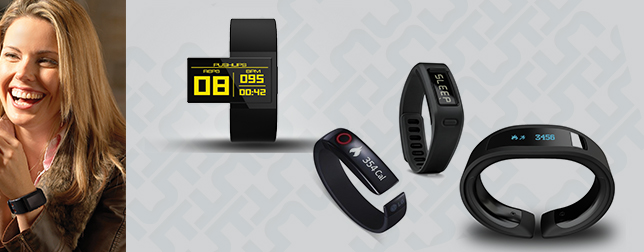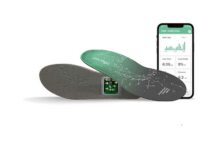From activity trackers to wristbands that track and notify you about all kinds of things – nobody is safe from this new wave of wristbands, in which brands, big and small, want to get their piece of the cake. Both, Bluetooth Smart as well as optical sensors are state of the art for most of these bands.
See also our new Smart Wristbands for 2015 Report.
Sony has now entered the fitness-tracking market with Core, a tiny chip that they are planning to put into a number of products, starting with SmartBand that will be released this spring. Core will include the typical fitness-tracking metrics, but Sony says it’ll also function as a kind of life journal, tracking photos you’ve taken and other life events. Three tiny LED lights serve as display that light up when you push the band’s single button. There’s also a vibration motor that notifies the wearer when a call is coming in, and it can also mute the connected smartphone. The button also pulls double duty for what Sony calls a “life bookmark,” something you tap to mark that particular point in the day to refer back to later in the accompanying smartphone app Lifelog.
LG unveiled its Lifeband Touch, a fitness tracker offering smartwatch features, including incoming call notifications and a display. It uses Bluetooth LE and works with both Android and iOS devices. You can switch tracks, play, and pause music. For fitness tracking, the Lifeband Touch can record steps taken, distance travelled, pace and calories burned. It has a built-in LED display to let you keep track of all that data without the need to turn on your phone and it is water resistant too. The Lifeband Touch starts shipping this spring in the U.S., along with the new LG Heart Rate Earphones. These use an optical sensor to measure the blood flow in the ears to determine heart rate, and add that data to the information collected by the Lifeband Touch itself.
Printer manufacturer Epson created its own piece of wearable tech with Pulsense, a bracelet capable of monitoring and storing your heart rate, activity level, calories burned and sleep pattern. Epson also launched a watch with a tiny light on the inside, you’ll find a tiny light, indicating Epson’s heart rate monitoring module that uses optical sensors to obtain an accurate heart rate.
From the partnership between motion-sensing tech company Movea and Bluetooth Low Energy leader Texas Instruments comes the G-Series high-performance multisport wristband. It features activity-tracking capabilities such as advanced sports and sleep monitoring, posture detection when standing and walking, step and distance counting, energy expenditure, running speed and cadency. In fact, the wristband allegedly has sleep tracking capabilities that closely mirror the results found in hospital performance tests. The wristband is very accurate and only has an error rate of less than 1.7% on average.
Mio, last year’s finalists of the Wearable Technologies Innovation World Cup, has now introduced a sleek wristband designed to continuously monitor your heart rate. It is called Mio Link and features Bluetooth Smart 4.0. Like in the Mio Alpha heart rate watch the new band uses optical sensors to measure heart rate. It transmits the data using Bluetooth to the Mio GO training application, and uses ANT+ technology to connect to other fitness apps and sport devices. The Mio Link further features a soft, silicone strap, tri-color LEDs to indicate heart rate zones, and a single button so users can start, stop, or sync the transmission of data. The Mio Link will start shipping in the beginning of March 2014.
Garmin, known for being one of the biggest providers of navigation devices, announced it too will focus on the booming wearables market with its new Vívofit fitness band. It’s a wrist-worn fitness tracker with a small screen that logs your steps and activity level. Vívofit will start off by learning your activity level — once it figures out a baseline, it’ll automatically assign you what it thinks will be an achievable daily goal. Once you start catching up to that goal and meet milestones, it’ll update your goal for the following day. The Vívofit also capitalizes on the thought that people are healthier when they get out of their chairs and enjoy small bits of activity throughout the day — if a user has been sitting inactive for more than an hour, the Vívofit will show a red bar that builds up as you stay seated. But if you get up and get moving, you can get yourself “out of the red.”
Razer is best known for its stylish peripherals and gaming laptops. Now the company is jumping into the fray with a smartwatch and tracking band mash-up called the Nabu. It’s a stylish band that melts smartphone notifications with a suite of fitness-tracking features, and two OLED screens. The smaller on the outside of your arm lights up, notifying you with icons for emails or calls that you received one of both. The larger “private” screen is on the inside of your arm, and displays the name of the caller or other more specific details. The device will work with both iOS and Android phones over Bluetooth Low Energy. It also features an accelerometer and altimeter for counting steps walked, stairs climbed, and for tracking your sleep.
As a result of another teaming-up between the startup Valencell, manufacturer of sensor technology for mobile health and fitness, and accessories manufacturer Scosche Industries the Rhythm Smart+ was created. The wristband heart monitor optically measures blood flow and movement to calculate heart rate and calories burned more accurately than conventional heart rate monitors. The dual mode wireless configuration includes Bluetooth Smart and ANT + capabilities, allowing it to pair with smartphones, sport watches and exercise equipment from up to 100 feet. With the onboard memory you can work out in freeRUN mode without the need to carry your smartphone with you.
Atlas is a startup with a very ambitious fitness wristband. It is capable of determining exactly what exercises you’re doing and giving you a better sense of both your fitness level and your form. Thanks to a built-in accelerometer, Atlas continuously keeps track of its movement. While all that is going on, an algorithm chews on all of that spatial data to try and figure out what exactly you’re doing at any given moment. Meanwhile, the Atlas’ backside includes an optical pulse sensor to determine just how hard you’re actually working out, which when combined with all that other data should yield one of the more thoughtful quantified fitness experiences.
Atlas Wearables from Atlas Wearables on Vimeo.
Jaybird is back with Reign, its fitness band that monitors your vitals. Like many of its wearable brethren, but with one major distinction. It comes packed in with the software “Go-Zone” which purports to read minute body indicators in order to know the best time for you to work out. Then, it reminds you so you can feel the appropriate amount of guilt. Also, to round up the package, it monitors your sleep so you can find out yet another thing you are not good at. The Reign will work with both iOS and Android phones.
Last but not least in our endless list of new wristbands there is the ERI from Digi-Care which tracks motion, distance, and time, all without GPS. The Digi-Care ERI Wristband features magnetic tracking with an OLED screen and a compatible app. The wristband tracks your distance using a unique magnetic distance sensor, as well as motion, temperature, and pressure sensors, allowing you to take it running, hiking, swimming, or anywhere else you like to go. The wristband introduces a new competitive feature to your workout, awarding points when you reach certain goals. You can race, compete, and earn points and ‘prizes’ in any activity, which should technically give you more motivation to actually do them. Because it measures your time and your speed, you can directly compare your results to friends, strangers, or whomever else you want. The app also tells you where you’re going, points out your route, and gives you an overall rating based on your activity.
ERI – The thinnest route tracking smart sport wristband. from DigiCare on Vimeo.
It seems that 2014 will be the start of an era for wrist-worn wearables. However, the question remains which one to choose…














